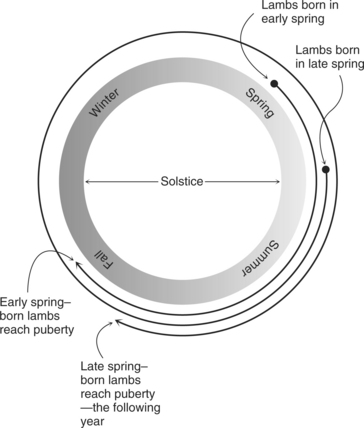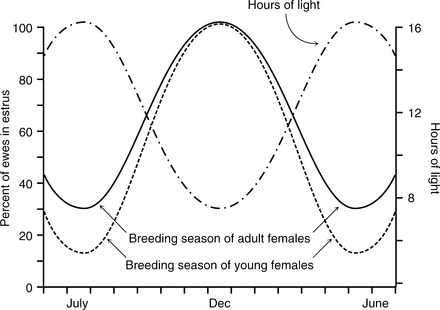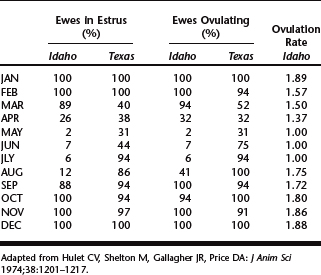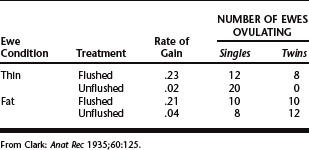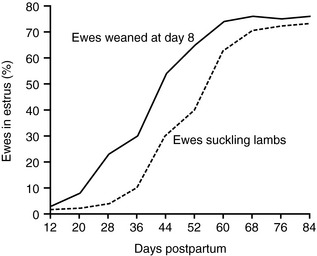CHAPTER 88 Sheep Breeding Strategies
Sheep are among the most versatile of the livestock species managed today in adaptability to diverse production environments and purveyors of various products throughout the world. Certainly the origin of this diversity evolves from the 400 to 800 different breeds of sheep that exist worldwide. As an example, although most sheep breeds birth 1 to 3 lambs per lambing, unique breeds such as the Booroola Merino exists functionally as litter-bearing ruminants, giving birth to 6 or more offspring per lambing. Compounding this diversity among breeds is the fact that sheep are seasonal short-day breeders, and adherence to or deviation from the short-day breeding activity will vary with the geographic latitude of their origin and subsequent management. Therefore, as advantageous as this diversity may be, it also imposes the liability that one set of recommendations cannot fit all paradigms. The objective with this chapter therefore is to describe the major variables that influence breeding activity and subsequent lambing performance in a manner that allows the informed individual to plan or diagnose schemes for managing breeding strategies that optimize ewe production performance.
CONSIDERATIONS IN SELECTING A BREEDING STRATEGY
Breeding Ewe Lambs
From a producer’s perspective, a major dilemma exists in the decision of which ewe lambs should be kept as replacement females to enter the flock and which ewe lambs should be sold to capture market lamb prices while that “window of opportunity” still exists. Certainly the animal’s genetic merit, production potential, and structural integrity are important variables to consider, but perhaps not as critical, but still significant, are the answers to the following two questions: (1) Will the selected ewe lambs ever achieve reproductive competence—(given that 10% to 20% of ewe lambs may possess some anomaly that prohibits the ability to ever reproduce)? (2) If the ewe lambs are capable of reproducing, when will they exhibit that capability (research has noted that ewe lambs that reach puberty at an early age are more reproductively efficient throughout their lifetime than are ewe lambs that reach puberty at an older age)? The factors that regulate the age at which lambs reach puberty can be categorized as genetic, environmental, and the interactive effects of genetics and environment.
There are many environmental determinants of a lamb’s age at puberty; however, the most frequently overlooked factor is the nutritional status of the developing lamb. The relationship between age and weight (or “condition”) of lambs at puberty is critical. Figure 88-1 illustrates this relationship for lambs growing at three different rates. The long-dash line illustrates the growth rate of lambs belonging to a producer who overfeeds his lambs in an effort to minimize their age at puberty. What this producer will find is that the “long-dash line” lambs do not reach puberty until they also satisfy the minimum age requirements. The cost of this mismanagement or unnecessary investment in excess feed is evident in the excess weight or condition carried by the “long-dash line” lambs as they start to cycle. Furthermore, evidence now exists that animals carrying excess fat have reduced fertility.
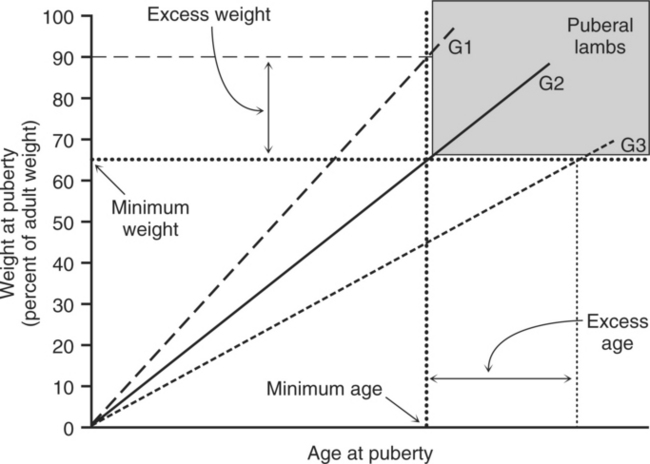
Fig. 88-1 Relationship between age and weight of lambs at puberty that are growing at three different rates.
Nonetheless, once the young dams lamb, it is critically important to feed them adequately to ensure their con tinued growth and development while lactating and beyond. Failure to adequately feed dams that lamb at a young age is one of the most common mistakes made by producers.
Also important in selecting replacement ewe lambs is their date of birth (Fig. 88-2). The reason for this selection variable is because in order for ewe lambs to reach puberty, they must first be exposed at an early age to increasing day lengths (summer solstice = June 21) and later to decreasing day lengths (winter solstice = Dec. 21), the latter of which provides the stimulus for them tobegin to cycle. Offspring born prior to June have the greatest likelihood of reaching puberty and starting to cycle during the subsequent fall or winter if conditions are favorable, whereas offspring born after June are less likely to reach puberty during the first fall or winter but will wait until the following fall or winter to reach puberty at over 1 year of age.
Finally, it should be noted (as illustrated in Fig. 88-3) that for ewe lambs, the breeding season will typically begin 3 weeks after the adult ewes and cease 3 weeks prior to the adult ewes. The consequence of these restrictions is reduced opportunity to conceive at a time in the ewe’s life when conception rates are typically low to begin with—thus the concern over delayed age at puberty.
Breeding Adult Ewes
A proportion of all ewes will cycle year round (also represented in Fig. 88-3 and Table 88-1) and typically for ewes living closer to the Equator (e.g., Idaho versus Texas), the proportion of ewes cycling year round increases. In contrast, it should be noted that relocation of breeds of sheep that are adapted to the equatorial latitude to locales more distant from the equator will result in a lower proportion of ewes cycling year round. As an example, efforts to establish a flock of ewes that breed year round in New York simply by importing ewes from the tropics will not be effective.
As an added note of caution, behavioral estrus and the occurrence of ovulation are not necessarily co-dependent. With this in mind, it is important to note that the proportion of ewes ovulating in Table 88-1 is often greater than the proportion of ewes that display estrus. This phenomenon is especially true during the times of the year when ewes make the transition into or out of the breeding season. The reason for this disconnect between estrus and ovulation may be due to either a failure in the ability to detect estrus or failure by the ewe to show estrus at the time of ovulation (silent estrus).
Finally, among ewes that cycle throughout the year, ovulation rate will vary with season of the year (see Table 88-1). More specifically, ewes that are bred during the summer months (e.g., June) produce fewer lambs (ovulation rate = 1) than the same ewes bred during the fall or winter months (ovulation rate = 1.7–1.8). This latter point is especially important to consider for producers who manage a program to breed ewes “out of season” (during the summer months) in an effort to produce more lambs per year.
EFFECT OF ENVIRONMENTAL TEMPERATURE
When seasons change, so does temperature. Temperature does not appear to play a major role in dictating the cyclic activity of ewes, but it does have a major detrimental effect on embryo survival, especially when temperatures are high during the week following breeding (Table 88-2). When ewes and rams were housed in a hot climate versus a cool climate, the hot weather resulted in a lower percentage of fertilized eggs, greater embryonic death, and consequently fewer ewes lambing. Any condition that limits an animal’s ability to cool itself (e.g., high humidity) adversely affects reproductive performance.
Table 88-2 Effect of Temperature on Variables of Reproductive Importance
| HOUSING FOR RAMS AND EWES (AUGUST) | ||
|---|---|---|
| Variable | Outside | Air-Conditioned Room |
| % eggs fertilized | 26% | 64% |
| % embryonic death | 49% | 22% |
| % ewes lambing | 13% | 50% |
Dutt and Simpson, 1957.
EFFECT OF EWE AGE AND BREED
Breed and age also affect the breeding activity of ewes (Table 88-3). Some breeds of sheep, such as Rambouillet, Merino, and Dorset, have longer breeding seasons than others, such as Southdown and Cheviot. Fortunately, long breeding seasons are genetically dominant; therefore, it is possible to increase the length of the breeding season through selective breeding. Within a breed, as an animal’s age increases, the length of the breeding season and fertility also increases (see Table 88-3). Ewe lambs that are starting to cycle for the first time generally tend to start cycling about 3 weeks after the adults and stop cycling about 3 weeks before the adults (see Fig. 88-3). As age increases, reproductive efficiency also increases when measured by number of surviving offspring (due, in part, to learned mothering ability) and number of offspring produced (due, in part, to an increase in ovulation rate as ewe age increases).
EFFECT OF NUTRITION
The rapid response of ewes receiving greater than National Research Council nutritional recommendations with an increase in ovulation rate has long been known and referred to as flushing. In order for the technique of flushing to be effective, it is usually initiated 2 to 3 weeks prior to the beginning of the breeding season and is accomplished by supplementing ewes with a high-energy feed such as 0.5 to 1.5 lb of corn per head per day. The most effective time of the year to use the technique of flushing to increase ovulation rates of ewes is when ovulation rates are marginal and especially when ewes are transitioning into or out of the breeding season. Flushing is also most effective in ewes with greater energetic demands. As can be seen in Table 88-4, regardless of the fact that both fat and thin ewes are gaining weight at an equivalent rate in response to the flushing stimulus, only the thin ewes respond with an increase in ovulation rate. It should also be noted that the increase in ovulation rate in response to the flushing stimulus does not exceed that capability exhibited by the fat ewes regardless of energy intake. Consequently, flushing is a short-term technique that merely permits the animal to express its genetic potential to ovulate. Neither flushing nor feeding theanimal in excess of its needs permits the animal to supersede its genetically defined limitations. In contrast, limiting nutrient availability not only reduces ovulation rates but also shortens the length of the breeding season, limits the animals’ milking ability, and compromises other systems related to production. Simply put, when animals are not fed, they fail to produce.
EFFECT OF STRESS
When considering the stress of suckling, ewes that suckle lambs take longer to return to estrus than ewes from which lambs have been weaned at an early age (Fig. 88-4). The recipe for predicting the outcome of stress management approaches may not always be as anticipated, depending on the source of the stress. Consequently, selective removal of specific stressful stimuli can produce responses that are either ineffective, permissive, or facilitating (e.g., ram introduction, discussed subsequently) to reproductive performance. The ability to predict the outcome of selective stressful stimulus requires the ability to collectively assess the total impact of that stress on the balance that exists between the animal’s inherent drive to reproduce and the demands that keep her from reproducing. For example, although early weaning of lambs may appear to provide a simple solution to accelerate the rebreeding of ewes, the technique is ineffective when used as the only stimulus to induce cyclic activity in ewes lambing during the spring or summer months. The differential response between groups of ewes lambing in the fall versus the summer can be attributed to the powerful inhibitory effects of long day lengths. In contrast, by creating an environment in which several inhibitory stressors are negated, using combined approaches, such as lamb removal and flushing, may be sufficient to initiate cyclic activity in ewes even in the presence of other inhibitory influences such as long day lengths.
Stay updated, free articles. Join our Telegram channel

Full access? Get Clinical Tree


